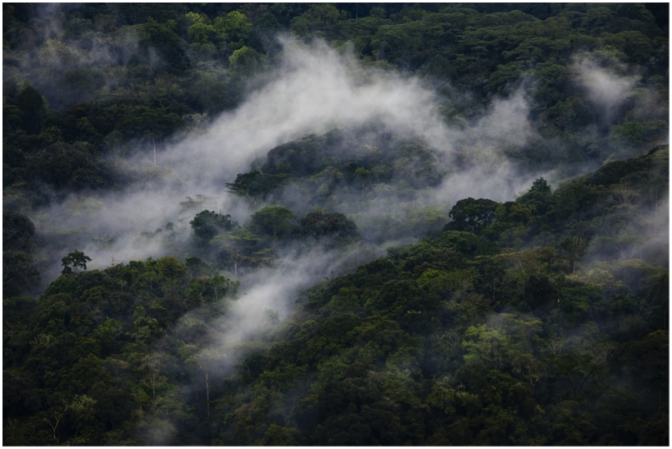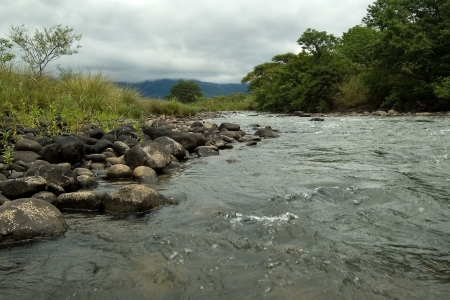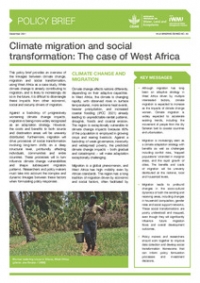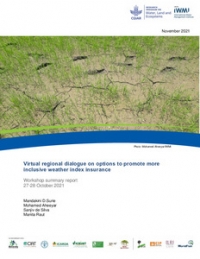Who would have thought that the restoration of natural habitats, such as cloud forests, could help keep the light bulb on a bit longer during periods of water scarcity and electricity rationing?
Electricity rationing is an issue of special concern nowadays for tropical countries like Brazil or Colombia that depend heavily on hydropower and that currently face risks from rationing. In Brazil, for instance, the risk of electricity shortages this year now tops 20%, well above the 5% that the government deems acceptable. The reason for this? Poor hydrology.
 Clouds rise through Bwindi Impenetrable National Park, home to the endangered mountain gorilla. Photo by: Benjamin Drummond. Conservation International
Clouds rise through Bwindi Impenetrable National Park, home to the endangered mountain gorilla. Photo by: Benjamin Drummond. Conservation InternationalA recent article in the Economist says that 80% of Brazil's electricity is generated by hydropower. But recent droughts and high temperatures have reduced reservoir storage by 60% in the south east and center west, which account for 70% of the country's total storage capacity. In Colombia, the situation is no more encouraging, with President Santos calling for water and energy saving to respond to the drought crisis that several regions face this year.
But also in the case of Colombia, as water quality declines, poor environmental management and performance are likely to be blamed for the stronger than normal impacts of drought. It seems important for energy planning and expansion activities in these countries to illustrate the fact that optimization of infrastructure from environmental (green) and conventional (grey) engineering should be applied jointly to develop a more optimal energy expansion, with co-benefits such as carbon sequestration and biodiversity conservation. This is precisely the argument defended and demonstrated by my co-authors and I in a recent paper.
Dam energy output increases with restored cloud forests
We demonstrated that the Calima dam in Colombia could increase energy output by about 5% after simulating cloud forest restoration in less than 36% of the watershed area. Cloud forests are tropical forests that have a high cloud cover frequency throughout the year. Restoring cloud forest coverage regulates water flows and reduces sedimentation in dams.
Energy gains from restored cloud forests can be higher or lower depending on the plant and reservoir volumes, operational regimes, climate and topography, among others. However, energy security benefits are likely to be greater in other Colombian dams that already face significant sedimentation problems, have lost greater proportions of cloud forest upstream and enjoy lower reservoir capacities compared with the Calima dam.
By understanding the current regulations for energy security and expansion in Colombia, which shares similarities to that of countries like Brazil, Peru and Chile, if this extra power reliability, in the form of standing cloud forests, could be recognized in the current Colombia’s regulation for energy security and expansion, the company who runs the Calima dam could generate between 5% to 10% more revenue depending on the degree of water scarcity during a given year.
Also, greater protection and restoration of cloud forests in Colombia with the engagement of the hydropower sector, and consequent compensation for poor landowners that switch to cloud forest restoration, could complement watershed management activities of other mechanisms like Payments for Watershed Services (PWS), which are also working to reduce poverty in the steep areas where cloud forests are being cleared or have already been cleared.
Power supplies from tropical dams become more reliable
However, the importance of cloud forest restoration for hydropower performance is not just exclusive to Colombia. An earlier study indicates that 41% of the global remaining cloud forests filter a large proportion of the high quality water that ensures the operation of tropical dams, and yet our planet has lost already more than 55% of those important water fabrics.
Since many existing tropical dams may already be working at suboptimal levels due to cloud forest loss, cloud forest restoration could increase the power reliability of existing dams across the tropics in addition to mitigating the impact of droughts on electricity shortages that countries like Colombia or Brazil are facing today. This also justifies their better stewardship.
In collaboration with field offices, Conservation International and partners are piloting these ideas in countries like Colombia by working with dam companies that a have demonstrated opportunity to create energy security through the protection of critical cloud forests.
As a result, the Mining and Energy Planning Unit of Colombia is beginning to plan incentives for hydropower companies to protect and restore cloud forests in Colombia, which could also compensate poor landowners in these regions who focus on the management and restoration of these forests.
As new green energy opportunities expand around the world, it seems that the smart conservation of cloud forests can be a truly viable solution to enhance energy security in water scarce years, which can also ensure the survival of some of the planet’s most biodiversity-rich ecosystems and the communities who depend on them.
This study was led by Dr. Leo Saenz, Director of Eco-hydrology at Conservation International in collaboration with King’s College London, the Challenge Program on Water and Food (CPWF) and BlueSmart, a consulting and environmental engineering company.


















